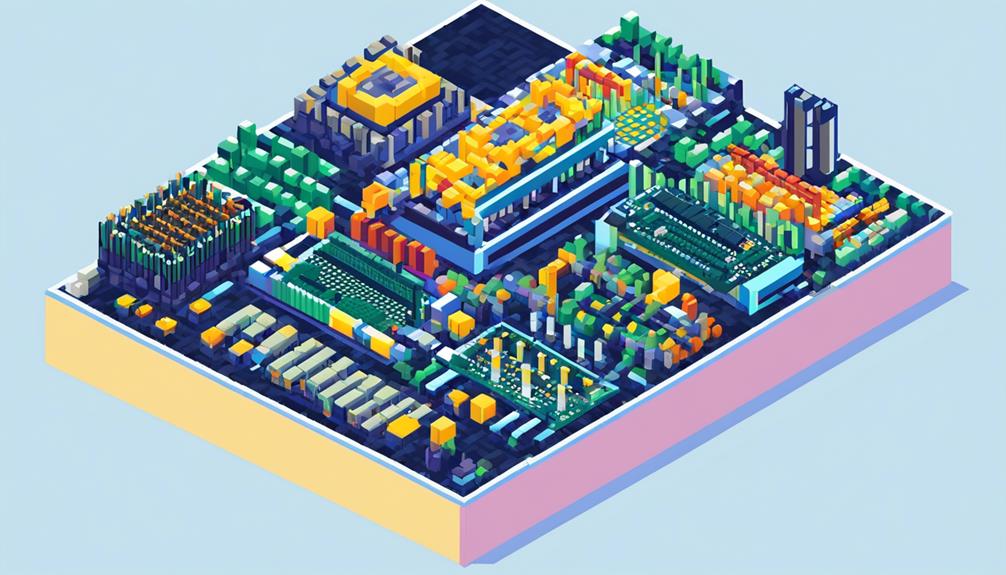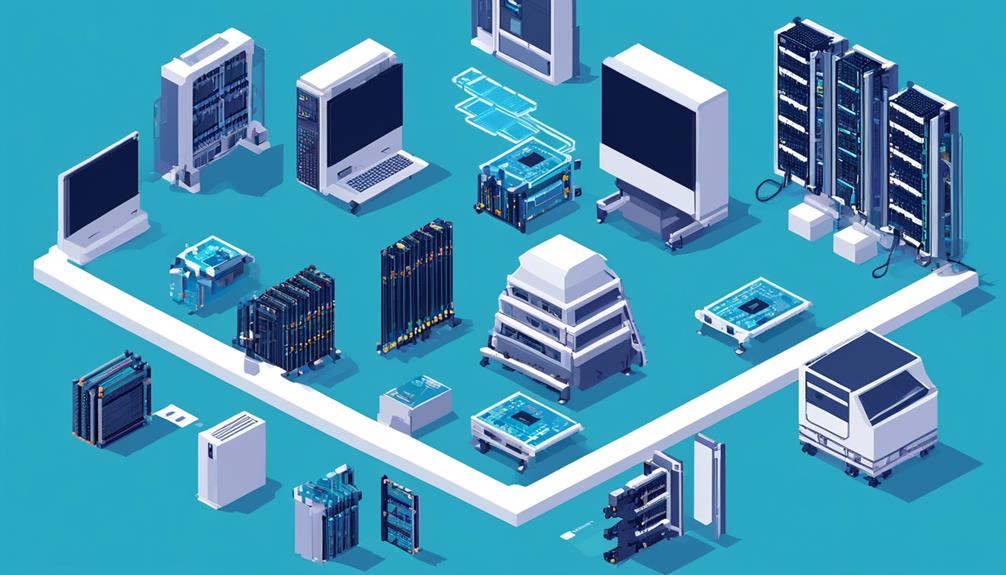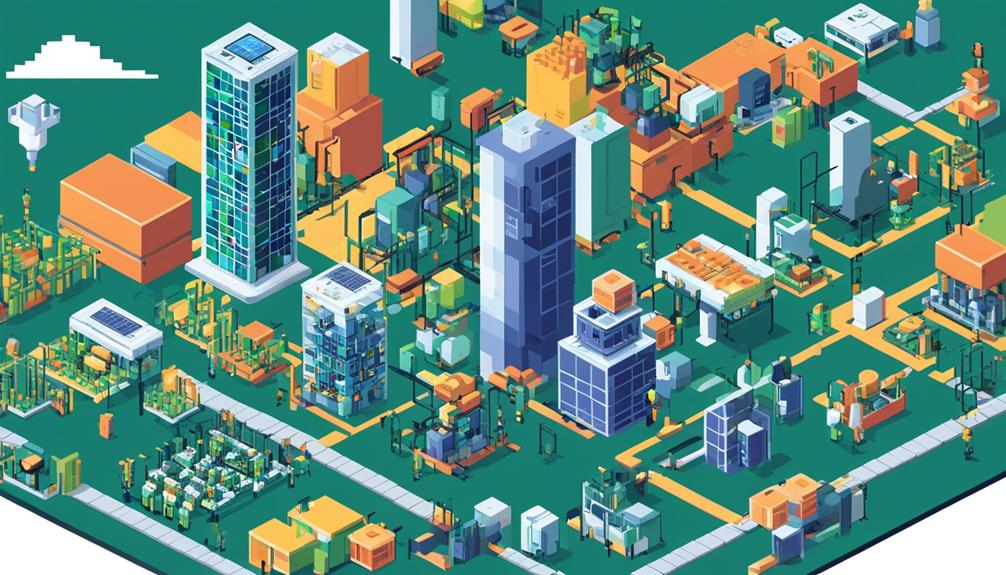Cost-effective edge computing hardware is a crucial consideration for organizations seeking to optimize their edge computing infrastructure. With the increasing demand for real-time data processing and storage at the network edge, it becomes essential to explore strategies that not only meet application requirements but also minimize costs.
In this discussion, we will delve into the key considerations for cost-effective edge hardware, evaluate different options available, examine factors that affect edge computing hardware costs, and explore best practices for implementation.
By the end, you will have a comprehensive understanding of how to strike a balance between performance and affordability in your edge hardware investments, while also uncovering cost-saving strategies for efficient deployment.
Key Takeaways
- Evaluating existing infrastructure is crucial before adding new edge computing hardware or software.
- Choosing between building or buying AI applications should be based on cost and customization needs.
- Proper monitoring and maintenance practices should be implemented to optimize performance and reduce costs.
- Leveraging edge devices for real-time data processing and storage can help minimize data transfer costs and improve response times.
Key Considerations for Cost-Effective Edge Hardware

When considering cost-effective edge hardware, organizations must carefully evaluate components such as systems, sensors, compute systems, and network, taking into account existing infrastructure. This is crucial because the cost of edge computing can vary significantly depending on factors such as scale, data, location, and expertise. By analyzing these key considerations, organizations can optimize their edge hardware strategies for cost-effectiveness.
One of the primary considerations for cost-effective edge hardware is the choice between building, buying, or using a hybrid approach for AI applications. Prebuilt applications can range from thousands to tens of thousands of dollars, while custom applications can cost up to hundreds of thousands of dollars. Organizations must weigh the benefits of customization against the higher costs associated with developing custom applications.
Another crucial consideration is the management of edge computing infrastructure. The highly distributed nature of edge computing presents unique challenges in terms of management. Organizations may need to invest in specialized management solutions, resulting in increased licensing costs. Alternatively, they may consider outsourcing management to third-party providers, which can also impact the overall cost.
Additionally, edge computing hardware plays a pivotal role in enabling cost savings. By leveraging edge hardware, organizations can reduce their reliance on central data centers and cloud services, resulting in lower infrastructure costs. Edge hardware also facilitates faster processing and improved performance, leading to increased efficiency and potential cost reductions.
Evaluating Edge Computing Hardware Options
To effectively evaluate edge computing hardware options, organizations must carefully consider factors such as infrastructure, application, and management costs, as well as the specific requirements of their scale, data, location, and expertise. When evaluating edge computing hardware options, organizations should assess their existing infrastructure, including components such as sensors, compute systems, and networks, as these significantly impact the cost.
One strategy is to build edge devices in-house, allowing organizations to have complete control over the hardware specifications and customization. While this approach may require upfront investment and technical expertise, it provides the flexibility to tailor the hardware to specific requirements.
Another option is to buy off-the-shelf edge devices, which can be a cost-effective solution for organizations that have limited expertise or resources. These pre-built devices often come with standardized features and configurations, making them easier to integrate into existing systems.
Organizations can also opt for a hybrid approach, combining both in-house development and commercial devices. This strategy allows organizations to leverage their existing infrastructure while supplementing it with off-the-shelf devices where appropriate. This approach can offer a balance between cost-effectiveness and customization.
When evaluating edge computing hardware options, it is important to consider the potential cost savings and benefits that come with reduced latency and improved security. Edge devices can help reduce the amount of data that needs to be sent to the cloud, resulting in lower bandwidth costs and improved response times. Additionally, edge devices can enhance security by processing data locally and minimizing the exposure of sensitive information during transit.
Factors Affecting Edge Computing Hardware Costs

Factors affecting the cost of edge computing hardware encompass various aspects, including scale, data, location, expertise, and infrastructure components. These factors play a crucial role in determining the overall cost of implementing edge computing solutions. Understanding these factors is essential for organizations to make informed decisions and optimize their edge infrastructure investments.
Here are four key factors that influence the cost of edge computing hardware:
- Scale: The scale of the edge computing deployment significantly impacts the cost. Larger deployments require more hardware, sensors, and compute systems, resulting in higher upfront costs. However, larger scale deployments may also yield greater cost savings in the long run due to economies of scale.
- Data: The amount and complexity of data being processed at the edge can impact hardware costs. Edge computing reduces the need for centralized data centers by processing data locally, resulting in lower data transfer costs. However, organizations must invest in hardware capable of handling the data processing requirements at the edge.
- Location: The location of edge computing infrastructure can affect costs. Remote or harsh environments may require specialized hardware that can withstand extreme conditions, increasing the overall cost. Additionally, factors such as power availability and network connectivity can impact the selection and cost of edge computing hardware.
- Expertise: The level of expertise required to deploy and manage edge computing hardware can influence costs. Organizations can choose to build the necessary expertise in-house or opt for managed services, which may incur additional costs. It is essential to consider the availability of skilled personnel and the associated costs when evaluating edge computing options.
Best Practices for Cost-Effective Edge Hardware Implementation
Considering the factors that influence the cost of edge computing hardware, it is essential to implement best practices for cost-effective edge hardware implementation. One of the first best practices is to evaluate the existing infrastructure before adding new hardware or software. By leveraging the existing infrastructure, organizations can minimize additional costs and ensure efficient utilization of resources.
Another cost-effective strategy is to consider building or buying AI applications. Prebuilt applications are available at various price points, ranging from thousands to tens of thousands of dollars. These applications offer a cost-effective option for edge computing, providing organizations with ready-to-use solutions. On the other hand, custom applications can be more expensive, potentially costing hundreds of thousands of dollars. However, they can be tailored to meet specific business requirements, providing long-term value.
To manage edge computing environments cost-effectively, organizations can choose between dedicated edge AI management solutions or outsourcing management to system integrators or management partners. Dedicated solutions are priced based on usage and offer tailored features for edge deployments. Outsourcing management can be a viable alternative, as it allows organizations to leverage the expertise of external partners, reducing the need for in-house resources and potentially lowering costs.
In terms of edge computing hardware, selecting the right components is crucial for optimal performance and cost efficiency. Servers, processors, switches, and routers specifically designed for edge computing can reduce reliance on central data centers and cloud services, leading to potential cost savings and improved performance. Additionally, choosing the appropriate memory capacity and storage type, such as SSDs or HDDs, is important for achieving the right balance between performance and cost.
Optimizing Edge Hardware Investments

Edge hardware investment optimization involves strategic decision-making and careful analysis of Total Cost of Ownership (TCO) to maximize long-term cost benefits and performance improvements. By considering various factors such as infrastructure, application, and management costs, organizations can make informed decisions when evaluating their edge computing investments.
Here are four strategies to optimize edge hardware investments:
- Evaluate infrastructure requirements: Assess the specific needs of your edge computing network, including the number and location of edge nodes, to determine the most suitable hardware. Consider factors such as processing power, storage capacity, and connectivity options to ensure efficient data processing and transfer.
- Choose scalable and future-proof solutions: Select edge hardware that can accommodate the expected growth and evolution of your edge AI and IoT devices. Scalable solutions allow for easy expansion and integration of new devices, reducing the need for frequent hardware upgrades.
- Maximize operational efficiency: Optimize edge hardware investments by focusing on energy efficiency and minimizing maintenance costs. Choose hardware that offers low power consumption and robust remote management capabilities, allowing for efficient deployment, monitoring, and troubleshooting.
- Consider total cost of ownership: Beyond the initial purchase price, evaluate the TCO of edge hardware, including maintenance, support, and potential downtime costs. Consider the longevity and reliability of the hardware to ensure long-term cost savings.
Balancing Performance and Affordability in Edge Hardware
Achieving the optimal balance between performance and affordability is a critical consideration when it comes to edge hardware investments. Strategic deployment of cost-effective edge computing hardware is necessary to ensure efficient and reliable operations while minimizing expenses. To strike this balance, businesses must carefully evaluate the initial investment cost alongside long-term cost savings.
The affordability of edge computing hardware is influenced by various factors. Technological advancements, such as improved manufacturing processes and increased competition, have led to reductions in hardware costs over time. Economies of scale also play a role, as higher production volumes can result in lower per-unit costs. Additionally, emerging business models like Edge-as-a-Service (EaaS) offer cost-effective alternatives, allowing organizations to access edge computing hardware on a pay-per-use basis.
When it comes to edge computing applications, the performance of the hardware is crucial. Central processing units (CPUs), graphics processing units (GPUs), and field-programmable gate arrays (FPGAs) are commonly used to achieve optimal edge computing performance. These hardware components are designed to handle complex computations, data processing, and real-time analytics, enabling businesses to extract valuable insights at the edge of their networks.
Fortunately, trends indicate that edge computing hardware is becoming increasingly affordable and attractive for businesses. As technology continues to advance and the market matures, the cost-effectiveness of edge hardware continues to improve. This makes it an appealing option for organizations seeking both cost reduction and performance improvement in their edge computing deployments.
Cost-Saving Strategies for Edge Hardware Deployment

When deploying edge hardware, it is crucial to consider cost-saving strategies to optimize budget allocation.
Hardware selection plays a critical role in achieving this goal. By choosing cost-effective edge computing hardware designed for specific applications, organizations can maximize performance while controlling costs.
Additionally, exploring edge-as-a-service models and leveraging existing infrastructure are effective strategies for achieving budget-friendly edge solutions.
Hardware Selection Tips
Consideration of existing infrastructure is crucial when selecting hardware for edge computing deployment, as it can help optimize costs and minimize the need for additional hardware or software. To ensure a cost-effective edge hardware selection, here are some tips to consider:
- Evaluate your current infrastructure: Assess the capabilities and limitations of your existing infrastructure to identify gaps and determine if any upgrades or modifications are needed.
- Consider a hybrid approach: Building, buying, or using a hybrid approach for AI applications can impact the overall cost of edge computing. Evaluate the trade-offs between building custom hardware or leveraging off-the-shelf solutions.
- Explore edge AI management solutions: Edge computing presents unique management challenges, and dedicated edge AI management solutions may be priced based on usage. Evaluate different vendors and their pricing models to find the most cost-effective solution for your needs.
- Leverage technological advancements: Technological advancements and economies of scale lead to lower prices for edge devices and related services. Stay updated on the latest developments in edge computing hardware to take advantage of cost-saving opportunities.
Budget-Friendly Edge Solutions
To optimize costs and make budget-friendly decisions for edge hardware deployment, it is essential to consider cost-saving strategies that can maximize the efficiency of your edge computing infrastructure. By implementing these strategies, businesses can reduce the upfront and ongoing costs associated with edge computing.
One cost-saving strategy is to carefully select the hardware for edge deployment. Choosing cost-effective edge computing hardware that meets the specific requirements of the workload can help reduce expenses. Additionally, leveraging open-source hardware solutions or repurposing existing hardware can further minimize costs.
Another strategy is to leverage cloud services for certain edge computing tasks. Offloading non-latency-sensitive workloads to the cloud can reduce the need for expensive edge hardware and help in cost optimization.
Furthermore, optimizing data transport and storage can contribute to cost savings. Utilizing compression techniques, data deduplication, and efficient data storage mechanisms can reduce the amount of data that needs to be processed and stored at the edge, resulting in lower infrastructure costs.
Implementing edge computing brings numerous benefits, such as reduced latency and improved reliability, making it ideal for Internet of Things (IoT) applications. By adopting cost-effective edge computing hardware and implementing cost-saving strategies, businesses can leverage the benefits of edge computing while keeping their budgets in check.
| Cost-Saving Strategies |
|---|
| Carefully select cost-effective edge computing hardware |
| Leverage cloud services for non-latency-sensitive workloads |
| Optimize data transport and storage mechanisms |
| Utilize compression techniques and data deduplication |
| Repurpose existing hardware or explore open-source solutions |
Future-proofing Your Edge Hardware Investment
Future-proofing your edge hardware investment is crucial for long-term viability, scalability, and adaptability. To ensure the longevity of your investment, it is essential to select hardware that can meet the increasing demands of resource-intensive applications. This consideration should include factors such as CPUs, GPUs, FPGAs, memory, and storage.
Long-Term Hardware Viability
Ensuring the long-term viability of edge computing hardware involves strategic planning and adaptability to evolving technologies. To future-proof your edge hardware investment and maximize its lifespan, consider the following strategies:
- Scalability and Flexibility: Invest in hardware that can easily scale and adapt to changing workloads and requirements. This allows for future upgrades and expansion without the need for significant hardware replacements.
- Regular Evaluation: Continuously assess the performance and capabilities of your edge hardware to identify any potential bottlenecks or limitations. This enables proactive measures to be taken to maintain optimal performance and extend the hardware's lifespan.
- Compatibility with Emerging Standards: Choose hardware that is compatible with emerging edge computing standards and protocols. This ensures that your investment remains relevant and compatible with future technologies and ecosystems.
- Upgradeability: Select hardware that supports hardware upgrades and can accommodate future advancements in technology. This allows for cost-effective upgrades rather than complete hardware replacements.
Scalability and Adaptability
With the importance of scalability and adaptability in future-proofing edge hardware investments, businesses must carefully select hardware that can effectively handle increased workloads and seamlessly adapt to emerging technologies and standards. Scalability ensures that edge computing systems can efficiently accommodate growing data processing needs, while adaptability allows businesses to stay ahead by incorporating new technologies and standards without the need for frequent hardware upgrades. By investing in scalable and adaptable edge hardware, businesses can reduce bandwidth requirements and achieve lower latency, enabling faster and more efficient processing at the edge of the network. To demonstrate the significance of scalability and adaptability, consider the following table:
| Scalability | Adaptability |
|---|---|
| Allows for easy expansion of edge environments | Enables integration of emerging technologies |
| Accommodates increased data processing needs | Facilitates seamless adoption of new standards |
| Reduces the need for frequent hardware upgrades | Future-proofs edge computing infrastructure |
| Enables efficient resource allocation | Provides a foundation for long-term success in edge computing |
Cost-Efficient Future-Proofing
To achieve cost-efficient future-proofing of your edge hardware investment, it is crucial to consider long-term technological advancements and scalability. By investing in edge hardware that can adapt to evolving use cases and support emerging business models like Edge-as-a-Service (EaaS), you can ensure the longevity and cost-effectiveness of your infrastructure.
Here are four strategies for cost-efficient future-proofing:
- Versatile connectivity options: Choose edge hardware that supports various connectivity options, such as wired and wireless, to accommodate future advancements in network technologies.
- Latest processor support: Opt for edge hardware that can handle the demands of future applications by ensuring compatibility with the latest processors and computational capabilities.
- Scalable data handling: Select edge hardware that can handle the projected rise in global digital data consumption, enabling you to scale your infrastructure without incurring excessive costs.
- Industrial-grade construction: Invest in edge hardware with robust construction and reliability, reducing the overall maintenance and replacement costs over time.
Frequently Asked Questions
What Makes Edge Computing Cheaper?
Edge computing is cheaper due to various factors.
Firstly, it offers cost-saving techniques such as reducing bandwidth costs and minimizing infrastructure expenses by processing data closer to devices.
Additionally, optimization strategies like efficient resource allocation and scalability improve cost efficiency.
Affordable edge devices play a crucial role in lowering hardware expenses.
Lastly, conducting ROI analysis for edge computing implementation helps determine the financial benefits.
What Hardware Is Used in Edge Computing?
Edge computing applications require specialized hardware components to ensure efficient and reliable operations. These include:
- Edge computing processors, which are designed to handle resource-intensive tasks at the edge of the network.
- Networking infrastructure plays a crucial role in connecting edge devices and enabling seamless data transfer.
- Edge computing storage solutions are essential for storing and accessing data locally.
- Security measures are also vital to protect sensitive data at the edge.
In addition to these hardware considerations, there are other factors to take into account for effective edge computing implementation:
- Power consumption: Edge devices often operate in remote or resource-constrained environments, so minimizing power usage is crucial.
- Deployment challenges: The distributed nature of edge computing requires careful planning and coordination to ensure successful deployment across multiple locations.
- Scalability options: As the volume of data and the number of connected devices increase, edge computing systems must be able to scale up to meet growing demands.
Which Solution Would Benefit the Most by Using Edge Computing?
Edge computing would benefit various solutions that require real-time data processing and low latency.
IoT applications, autonomous vehicles, video surveillance, smart cities, augmented reality, remote monitoring, and industrial automation are among the solutions that would see significant advantages.
By enabling local data processing and reducing reliance on centralized cloud processing, edge computing can improve the efficiency and reliability of these applications.
It offers the potential for reduced network bandwidth, improved response times, and enhanced privacy and security in these scenarios.
Is Edge Computing Costly?
Edge computing can be costly, but cost considerations can be mitigated through a thorough ROI analysis.
Edge computing hardware may require higher upfront costs compared to cloud computing, but it can provide long-term cost benefits by reducing bandwidth requirements and improving data privacy.
Scalability issues can be addressed by implementing cost-saving measures and adopting budget-friendly edge computing solutions.
Small businesses can benefit from edge computing as it offers cost-effective measures for backup, disaster recovery, and accessing mission-critical applications.
